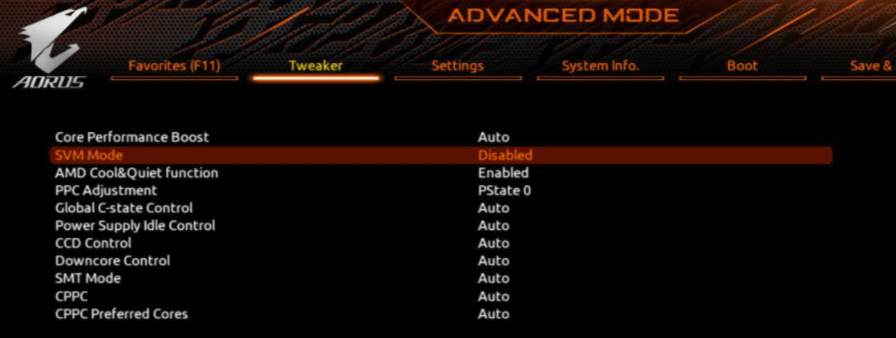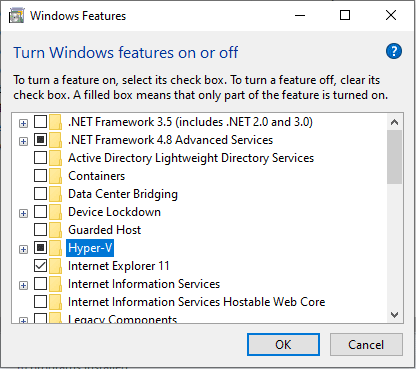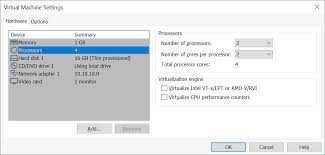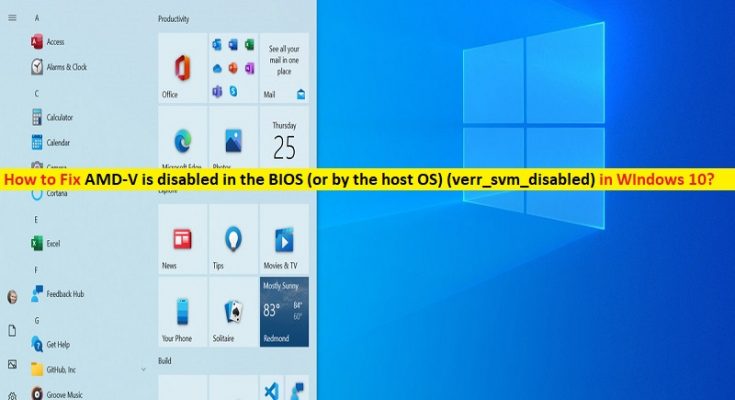What is ‘AMD-V is disabled in the BIOS (or by the host OS) (verr_svm_disabled)’ in Windows 10/11?
In this article, we are going to discuss on How to fix AMD-V is disabled in the BIOS (or by the host OS) (verr_svm_disabled) in Windows 10/8/7 or Windows 11. You will be guided with easy steps/methods to resolve the issue. Let’s starts the discussion.
‘Oracle VM VirtualBox’: Oracle VM VirtualBox or VirtualBox is type-2 hypervisor for x86 virtualization designed & developed by Oracle Corporation. VirtualBox was originally created Innotek GmbH, which was acquired by Sun MicroSystems in 2008 and which was in turn acquired by Orable in 2010. VirtualBox is available for Microsoft Windows OS, MacOS, Linux, Solaries and OpenSolaries. It supports the creation and management of guest virtual machines running Windows, Linux, BSD, OS/2, Solaris, Haiky, and OSx86.
However, several users reported they faced AMD-V is disabled in the BIOS (or by the host OS) (verr_svm_disabled) error on their Windows 11/10/8/7 computer when they tried to start a virtual machine using Oracle VM VirtualBox. This issue indicates you are unable to start virtual machine using VirtualBox Software in your Windows computer for some reasons. The error is appeared with message saying ‘Failed to open a session for Virtual machine Windows 7/8/10/11’ along with ‘AMD-V is disabled in the BIOS (verr_svm_disabled)’ error.
Reasons behind ‘AMD-V is disabled in the BIOS’ error – VirtualBox:
The possible reasons behind the issue can be the disabled AMD-V option in BIOS settings in your Windows computer, interference of Microsoft Hyper-V feature with AMD-V technology, issue with BIOS firmware version that doesn’t support this many CPU cores, issue with VirtualBox Software or bug in it, and other Windows issues. It is possible to fix the issue with our instructions. Let’s go for the solution.
How to fix AMD-V is disabled in the BIOS (or by the host OS) (verr_svm_disabled) error in Windows 10/8/7 or Windows 11?
Method 1: Fix ‘AMD-V is disabled in the BIOS (verr_svm_disabled)’ error with ‘PC Repair Tool’
‘PC Repair Tool’ is easy & quick way to find and fix BSOD errors, DLL errors, EXE errors, problems with programs/applications, malware or viruses issues, and other system issues with just few clicks. You can get this tool through button/link below.
Method 2: Enable AMD-V option in BIOS settings in your Windows computer

One possible way to fix the issue is to enable AMD-V from BIOS settings in your Windows computer.
Step 1: Restart your computer and when booting initiate, press ‘F2’, ‘Delete’ key on keyboard or other BIOS supported key to enter into BIOS setting page in your computer
Step 2: Once you are in BIOS settings page, go to ‘Advanced > CPU Configuration’. In this tab, make sure ‘AMD-V’ or ‘AMD SVM’ is enabled. If not, enable this option and then press ‘F10’ key on keyboard to save the changes and Exit from BIOS, Once done, check if the issue is resolved.
Method 3: Disable Microsoft Hyper-V

Interference of Hyper-V feature could be reason behind the issue. You can disable Windows Hyper-V in order to fix.
Step 1: Open ‘Windows Features’ or ‘Turn Windows Features ON or OFF’ window via Windows Search Box in your computer
Step 2: Find and deselect ‘Hyper-V’ checkbox, and hit ‘Ok’ button to save the changes. Once done, restart your computer and check if the issue is resolved.
Method 4: Change the Number of CPU Cores to ‘1’

If the VirtualBox is forced to created a virtual machine with more than 1 CPU core, it will require hardware virtualisations. However, if AMD-V technology is not supported by your current configuring, the virtualization procedure will not complete successfully and you will get the error. You can fix the issue by changing CPU cores to ‘1’.
Step 1: Open ‘VirtualBox’ Software, right-click on machine that is causing error, and click ‘Settings’
Step 2: Now, go to ‘System > Processor’ tab, drag the slider associated with Processor to ‘1 CPU’ and click ‘Ok’ button to save the changes. Once done, restart your virtual machine and check if the issue is resolved.
Method 5: Change version to Windows 7 or Windows 2003 (If applicable)
If the issue is still persist, you can try to fix the issue by changing Windows version to Windows 7 or Windows 2003 in VirtualBox.
Step 1: Open ‘VirtualBox’ software, right-click on virtual machine that is causing error, and select ‘Settings’
Step 2: Go to ‘General’ submenu, click ‘Basic’ tab, change Version using dropdown to either ‘Windows 2003’ or ‘Windows 7’ and hit ‘Ok’ to save the changes. Once done, restart your virtual machine and check if the issue is resolved.
Conclusion
I am sure this post helped you on How to fix AMD-V is disabled in the BIOS (or by the host OS) (verr_svm_disabled) in Windows 10/8/7 with several easy steps/methods. You can read & follow our instructions to do so. That’s all. For any suggestions or queries, please write on comment box below.



